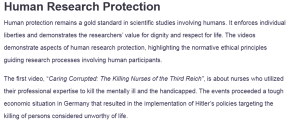Human Research Protection
Human protection remains a gold standard in scientific studies involving humans. It enforces individual liberties and demonstrates the researchers’ value for dignity and respect for life. The videos demonstrate aspects of human research protection, highlighting the normative ethical principles guiding research processes involving human participants.
The first video, “Caring Corrupted: The Killing Nurses of the Third Reich”, is about nurses who utilized their professional expertise to kill the mentally ill and the handicapped. The events proceeded a tough economic situation in Germany that resulted in the implementation of Hitler’s policies targeting the killing of persons considered unworthy of life.
Nurses held the children while being killed, placed them outside to die of hypothermia, starved them of food, and overdosed them (UTHealth Nursing, 2017). The events during the Third Reich demonstrated a significant compromise in the human right to self-determination and justice. As evident in the video, the actions of the nurses and the Nazi physicians were selective to the handicapped populations. Likewise, the victims never had an opportunity to self-determine. This surmounted breaches in the rights of autonomy and justice.
The second video, “Research Ethics Involving Human Subjects”, provides an overview of ethical research. It highlights the evolution of research ethics and events that have shaped research ethics. A point in the video that is important regarding human rights protection was when the Nazi researchers immersed a body of a human in icy waters to determine how long it would take for the human body to die in such conditions.
The Nazi experiment demonstrates significant compromise in ethical research. Many study participants did not provide consent for their participation in the experiments. Likewise, the harmful effects of the research process outweighed the benefits (irbmed, 2011).
The third video, “The Belmont Report (Part 1 Basic Ethical Principle)”, is about the Belmont Report. The video details the events that resulted in the report and its particulars. In the video, research processes are distinguished from clinical practice. An instance of the video that has significance in human protection in research is the detailing of the normative principles underlining research processes (irbmed, 2011).
Respect for persons, justice, and beneficence are some of the ethical principles in research discussed in the video. Ethical conduct of research requires that the researchers ensure that the research is beneficial with minimal risks. Likewise, the researchers must respect individuals’ autonomy, including persons with limited ability to self-determine. Researchers must also distribute the benefits and burdens of the research fairly across the populations.
The fourth video, “The Belmont Report (Part 2 Applying the Ethical Principles)”, is about the application of ethical principles. Informed consent processes, human subject selection, and risk/benefit analysis. The video highlights the significance of informed consent in research processes. Informed consent is integral to human research.
It affirms respect and dignity to human research participants. As per the Belmont report, informed consent involves informing the participants of what the research entails, the anticipated risks and benefits, and what their participation involves. This allows them to make decisions to participate without undue coercion.
The fifth video, “Guiding Principles of Institutional Review Boards (IRB)”, is about the IRB system. It highlights its evolution and its significance. IRB must be constituted of at least five highly qualified individuals (Johns Hopkins Medicine, 2015). IRB remains integral to human research protection.
A point in the video that highlights its significance is the narration of the role of the IRB. IRB informs specific aspects of human research, such as the age of the participants, and ensures informed consent and risk assessment are obtained.
References
Daigle, D. (2014, May 29). Research Ethics involving Human Subjects. [Video]. YouTube. https://www.youtube.com/watch?v=-O5gsF5oyls
irbmed. (2011, October 11). The Belmont Report (Part One: Basic Ethical Principles). [Video]. YouTube. https://www.youtube.com/watch?v=86zWBjDaXPk
irbmed. (2011, October 11). The Belmont Report (Part Two: Applying the Principles). [Video]. YouTube. https://www.youtube.com/watch?v=cIafASIIU70
Johns Hopkins Medicine. (2015, October 8). Guiding Principles of Institutional Review Boards (IRB). [Video]. YouTube. https://www.youtube.com/watch?v=iFik0of3iUM
UTHealth Nursing. (2017, February 25). Caring Corrupted: The Killing Nurses of the Third Reich. [Video]. YouTube. https://www.youtube.com/watch?v=Rz8ge4aw8Ws
ORDER A PLAGIARISM-FREE PAPER HERE
We’ll write everything from scratch
Question 
Week 2 Project
Assignment
Human Research Protection
During this course, you will learn the components required for a research study. Each week you will learn components of the research process through your readings and application of the knowledge gained to published research articles.
During this week, you are expected to examine the protection of human subjects in research from early research studies, through the development of research codes to current research standards.

Human Research Protection
The aim is to familiarize you with the ethical issues associated with research and gain firsthand information of the processes used to protect research participants.
Task:
View each of the You Tube clips listed below:
- https://www.youtube.com/watch?
v=Rz8ge4aw8Ws Caring Corrupted: The Killing Nurses of the Third Reich - https://www.youtube.com/watch?
v=-O5gsF5oyls Research Ethics - https://www.youtube.com/watch?
v=86zWBjDaXPk Belmont Report Part 1 - https://www.youtube.com/watch?
v=cIafASIIU70 Belmont Report Part 2 - https://www.youtube.com/watch?
v=iFik0of3iUM IRB (Institutional Review Board)
After viewing each video, write two paragraphs about each video describing the purpose from each video that you think is important regarding protecting human subjects in research and_provided rationale submission should be 400–500 words, using APA style